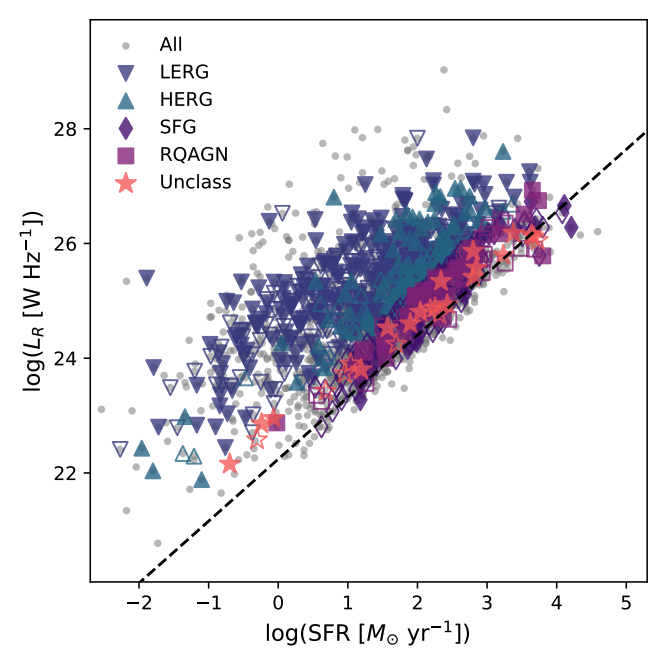CEA News, August 2022
Identifying active galactic nuclei via brightness temperature with sub-arcsecond international LOFAR telescope observations
Identifying active galactic nuclei (AGNs) and isolating their contribution to a galaxy's energy budget is crucial for studying the co-evolution of AGNs and their host galaxies. Brightness temperature measurements from high-resolution radio observations at GHz frequencies are widely used to identify AGNs. In a new paper led by a CEA Astronomer, we investigate using new sub-arcsecond imaging at 144 MHz with the International LOFAR Telescope to identify AGNs using brightness temperature in the Lockman Hole field.
 Figure 11 in the paper, this shows the L_R ∼ SFR relation. The line above which sources
are classified as radio excess is not explicitly drawn, but clear from the lower limit of
where LERGs/HERGs fall on the plot. Brightness temperature-identified AGN run the full
range of star formation rates and luminosities.
Figure 11 in the paper, this shows the L_R ∼ SFR relation. The line above which sources
are classified as radio excess is not explicitly drawn, but clear from the lower limit of
where LERGs/HERGs fall on the plot. Brightness temperature-identified AGN run the full
range of star formation rates and luminosities.
In this paper the authors have demonstrated, for the first time, the use of brightness temperature measurements at low (144 MHz) radio frequencies to identify 940 AGN. They find 83 percent of sources have AGN classifications from SED fitting and/or photometric identifications, yielding 160 new AGN identifications. Considering the multiwavelength classifications, brightness temperature criteria select over half of radio-excess sources, 32 percent of sources classified as radio-quiet AGNs, and 20 percent of sources classified as star-forming galaxies. Infrared colour-colour plots and comparison with what we would expect to detect based on peak brightness in 6 arcsec LOFAR maps imply that the star-forming galaxies and sources at low flux densities have a mixture of star-formation and AGN activity. They then separate the radio emission from star-formation and AGN in unresolved, brightness temperature-identified AGNs with no significant radio excess and find the AGN comprises 0.49 ± 0.16 of the radio luminosity.
Overall, the non-radio excess AGNs show evidence for having a variety of different radio emission mechanisms, which can provide different pathways for AGNs and galaxy co-evolution. This validation of AGN identification using brightness temperature at low frequencies opens the possibility for securely selecting AGN samples where ancillary data are inadequate.

